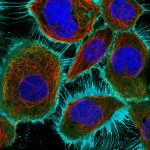Link to Pubmed [PMID] – 22226746
Curr. Biol. 2012 Jan;22(2):147-53
Cytokinesis bridge instability leads to binucleated cells that can promote tumorigenesis in vivo. Membrane trafficking is crucial for animal cell cytokinesis, and several endocytic pathways regulated by distinct GTPases (Rab11, Rab21, Rab35, ARF6, RalA/B) contribute to the postfurrowing steps of cytokinesis. However, little is known about how these pathways are coordinated for successful cytokinesis. The Rab35 GTPase controls a fast endocytic recycling pathway and must be activated for SEPTIN cytoskeleton localization at the intercellular bridge, and thus for completion of cytokinesis. Here, we report that the ARF6 GTPase negatively regulates Rab35 activation and hence the Rab35 pathway. Human cells expressing a constitutively activated, GTP-bound ARF6 mutant display identical endocytic recycling and cytokinesis defects as those observed upon overexpression of the inactivated, GDP-bound Rab35 mutant. As a molecular mechanism, we identified the Rab35 GAP EPI64B as an effector of ARF6 in negatively regulating Rab35 activation. Unexpectedly, this regulation takes place at clathrin-coated pits, and activated ARF6 reduces Rab35 loading into the endocytic pathway. Thus, an effector of an ARF protein is a GAP for a downstream Rab protein, and we propose that this hierarchical ARF/Rab GTPase cascade controls the proper activation of a common endocytic pathway essential for cytokinesis.

